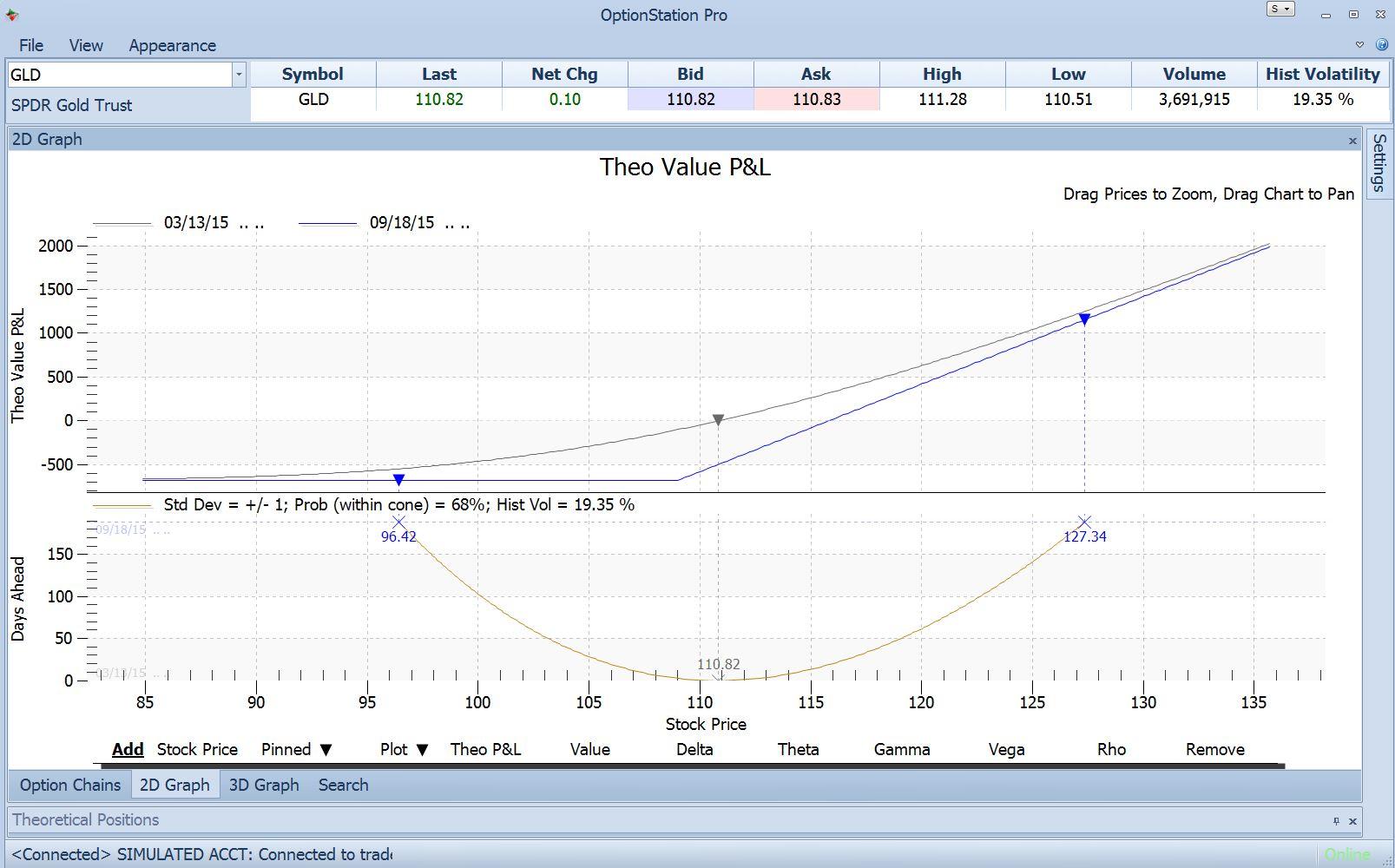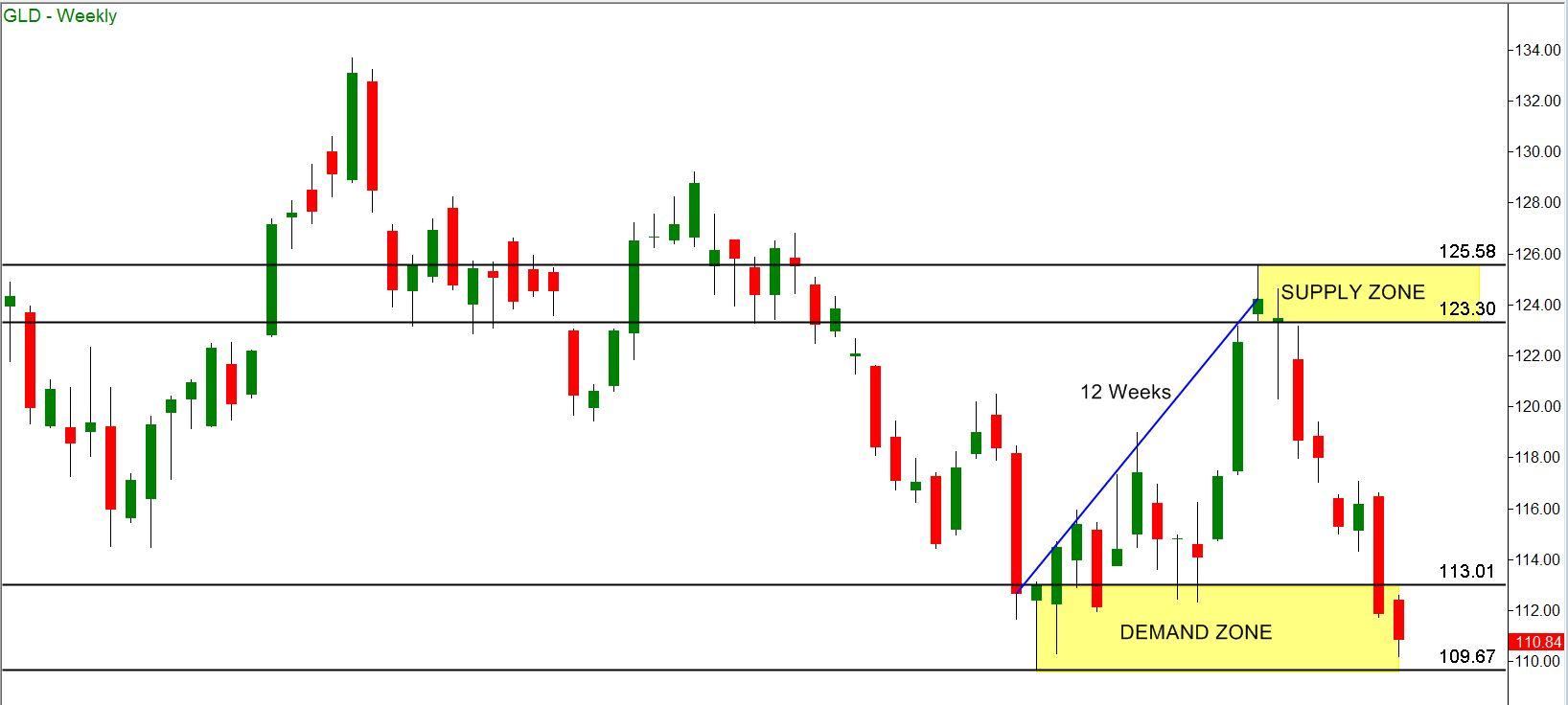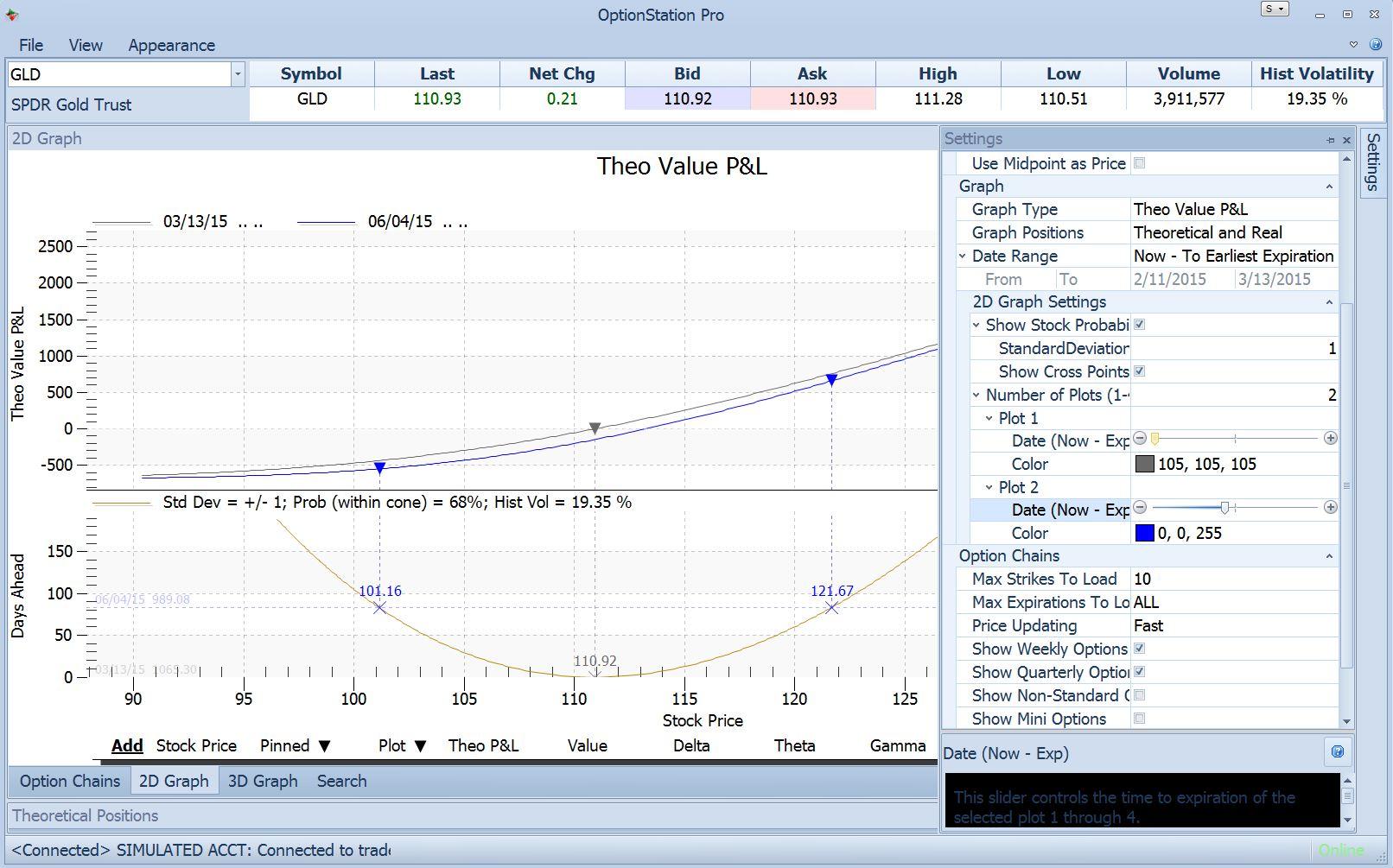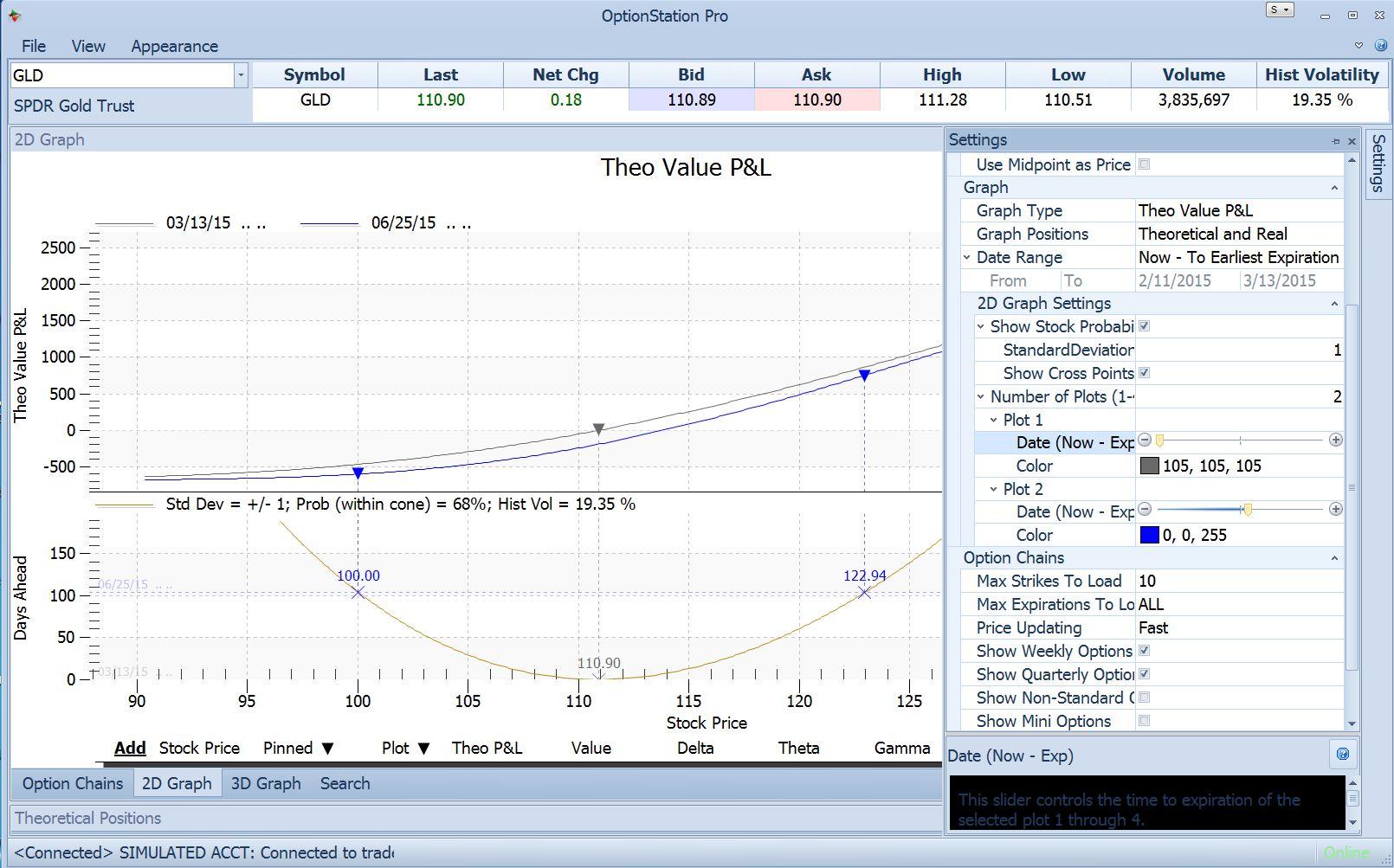In last week’s article, which you can read here, I began to describe the use of a terrific tool called the Volatility Cone. Today we’ll continue with that. If you haven’t read last week’s article previously, please read it first, as it is the first part of this discussion.
Our example had to do with GLD, the exchange-traded fund that tracks the price of gold. Here is how the price chart looked at the start of our example:
We were considering a bullish trade based on the demand zone in the $109-113 area, with a target around $123. Since that trek took twelve weeks last time it happened, we were estimating a similar amount of time for this trip.
Last time we created a theoretical option position involving the September $109 calls, and plotted a P/L graph together with a Volatility Cone. That diagram looked like this:

The gold arc in the bottom half of the chart is the Volatility Cone. As previously described, it indicates a one-standard-deviation price range from $96.42 to $127.34 for GLD as of the September expiration date on September 18, 2015.
But what we wanted to know was whether it was reasonable to expect that our target of $123 could be reached in our estimated twelve weeks. We’ll continue to work that out now.
The P/L graph in the upper part of the chart above has two lines or plots. The horizontal axis is the price of the ETF, and the vertical axis is the profit or loss our position (long one September 109 Call) would show for any price of GLD.
By default, the blue plot with straight lines is as of the expiration date, and the gray curved plot is as of today. We can adjust the date of the blue plot forward (closer) until it and its cross-points on the vol cone are as of our twelve-week target date, which would be June 5.
We make the adjustment in the Settings panel, under the 2D Graph Settings section, under Plot 1. We drag the Date slider to the left (to earlier dates) until the date reaches our 12-week target date, which would be June 5. The result is shown below. Note that the blue line is now curved, not straight; and that the legend at the top of the graph now shows a date of 06/04/15 for the blue line.
The blue label on the right-hand cross point in the vol cone now reads $121.67 which means that the one-standard deviation, 68%-probable range, tops out at that price as of our 6/5/15 target date.
Does that mean that GLD could only go to at most $121.67 and could not reach $123 by June 5? Of course not, it just means that going beyond $121.67 is pretty unlikely, under the assumption that GLD will move in the future with a volatility level that is similar to the recent rate.
If we want to see at what future date our target would fall within a 1-standard-deviation range and, therefore, be more likely to happen, that is easy to do. We just drag the Date slider for Plot 1 further to the right until the cross point reaches our $123 target. The closest we can get is $122.94. Here is the graph with that adjustment:
Very faintly, near the Days Ahead axis, we can see that this corresponds to a date of June 25, 2015. This is about three weeks further out than our 12-week estimate of June 5.
What this means is that it would be quite aggressive to expect such a move in 12 weeks, by June 5; but that it would be more reasonable to expect it to happen a few weeks after that. We need to select options that will still have at least two months of life remaining at our new revised target date of June 25. In other words, options that expire in August or later. If we had originally picked options with an expiration date earlier than August, we would now revise our plan.
So, in this case our main decision-making tool, as it always should be, was the location of quality demand and supply zones. Secondarily, we did a probability cross-check with the Volatility Cone which gave us the useful information that we should allow a few more weeks for this trade than we had originally estimated. This kind of information is crucial for options trades since one of our main decision points is the selection of an expiration date.
The Volatility cone has other related uses. For example, say that instead of a directional trade like this one we were contemplating a range-based trade. In such a trade we sell options whose strike prices are outside of a price range within which we expect a stock or ETF to stay for a while. We would identify those strikes, once again, by locating a good demand zone below the current price and a good supply zone above it. The vol cone could then be used to confirm that those strike prices were in fact far enough away from the current price that they were unlikely to be reached by the options’ expiration date. Strikes more than one standard deviation away from current price should be the minimum in that case, and more than two standard deviations would be even lower risk (remember that we would be selling options short in that situation and would want any options we sell to expire worthless).
I hope that these articles about probability have increased your understanding of how options work, and how we can use probability to our advantage when trading them.
This content is intended to provide educational information only. This information should not be construed as individual or customized legal, tax, financial or investment services. As each individual's situation is unique, a qualified professional should be consulted before making legal, tax, financial and investment decisions. The educational information provided in this article does not comprise any course or a part of any course that may be used as an educational credit for any certification purpose and will not prepare any User to be accredited for any licenses in any industry and will not prepare any User to get a job. Reproduced by permission from OTAcademy.com click here for Terms of Use: https://www.otacademy.com/about/terms
Editors’ Picks
EUR/USD holds above 1.0700 ahead of key US data

EUR/USD trades in a tight range above 1.0700 in the early European session on Friday. The US Dollar struggles to gather strength ahead of key PCE Price Index data, the Fed's preferred gauge of inflation, and helps the pair hold its ground.
USD/JPY stays above 156.00 after BoJ Governor Ueda's comments

USD/JPY holds above 156.00 after surging above this level with the initial reaction to the Bank of Japan's decision to leave the policy settings unchanged. BoJ Governor said weak Yen was not impacting prices but added that they will watch FX developments closely.
Gold price oscillates in a range as the focus remains glued to the US PCE Price Index

Gold price struggles to attract any meaningful buyers amid the emergence of fresh USD buying. Bets that the Fed will keep rates higher for longer amid sticky inflation help revive the USD demand.
Sei Price Prediction: SEI is in the zone of interest after a 10% leap

Sei price has been in recovery mode for almost ten days now, following a fall of almost 65% beginning in mid-March. While the SEI bulls continue to show strength, the uptrend could prove premature as massive bearish sentiment hovers above the altcoin’s price.
US core PCE inflation set to signal firm price pressures as markets delay Federal Reserve rate cut bets

The core PCE Price Index, which excludes volatile food and energy prices, is seen as the more influential measure of inflation in terms of Fed positioning. The index is forecast to rise 0.3% on a monthly basis in March, matching February’s increase.
RECOMMENDED LESSONS
Making money in forex is easy if you know how the bankers trade!
Discover how to make money in forex is easy if you know how the bankers trade!
5 Forex News Events You Need To Know
In the fast moving world of currency markets, it is extremely important for new traders to know the list of important forex news...
Top 10 Chart Patterns Every Trader Should Know
Chart patterns are one of the most effective trading tools for a trader. They are pure price-action, and form on the basis of underlying buying and...
7 Ways to Avoid Forex Scams
The forex industry is recently seeing more and more scams. Here are 7 ways to avoid losing your money in such scams: Forex scams are becoming frequent. Michael Greenberg reports on luxurious expenses, including a submarine bought from the money taken from forex traders. Here’s another report of a forex fraud. So, how can we avoid falling in such forex scams?
What Are the 10 Fatal Mistakes Traders Make
Trading is exciting. Trading is hard. Trading is extremely hard. Some say that it takes more than 10,000 hours to master. Others believe that trading is the way to quick riches. They might be both wrong. What is important to know that no matter how experienced you are, mistakes will be part of the trading process.



